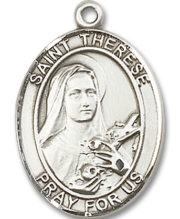Saints
St. Thérèse of Lisieux the Patron Saint of Missionaries
 Thérèse of Lisieux lived less than twenty-five years and at the time of her death only a handful of people knew that she had ever existed. Today, the whole world knows her; she is a canonized saint and she is the patron saint of all missionaries. The Catholic Church celebrates the feast day of St. There of Lisieux on October 3rd. Saint Therese of Lisieux, patron saint of missionaries, pray for us!
Thérèse of Lisieux lived less than twenty-five years and at the time of her death only a handful of people knew that she had ever existed. Today, the whole world knows her; she is a canonized saint and she is the patron saint of all missionaries. The Catholic Church celebrates the feast day of St. There of Lisieux on October 3rd. Saint Therese of Lisieux, patron saint of missionaries, pray for us!
The Biography of St. Therese of Lisieux
As you learn about the saints it is so easy to be impressed by the great things so many of them have done. They have braved every danger to bring the word of God to distant lands. Great preachers among them have talked to audiences numbering in the thousands. Bishops, kings, and popes have called in certain saints as advisers. Saints have led great armies. Many saints have been put to death for their faith.
But Thérèse shows us that it is not necessary to do spectacular deeds in order to become a saint. She achieved great heights of sanctity without ever leaving her convent. Her method consisted in doing little things well. For that reason, she called it the Little Way. Both parents of Thérèse Martin had, in their youth, wished to become religious; both had been rejected, without apparent reason, by superiors of the congregations to which they had applied.
They found God’s will in marriage and raised their family in the town of Alençon, in northern France., Five of their seven children lived to be adults and all five became religious. The youngest, Thérèse, was born January 2, 1873. Her mother died when she was only three years old. From her earliest days Thérèse had just one ambition: to become a saint.
By special permission of the bishop, Thérèse was allowed to enter the Carmel of Lisieux at the age of fifteen. Her two older sisters were already in the Carmel. Thérèse received the religious habit on January 10, 1889, and the black veil on September 24, 1890. Sister Thérèse spent nine years in the Carmel of Lisieux, growing spiritually while she wasted away physically. Those who lived with her saw her do nothing extraordinary. It was the custom for the superior, upon the death of a sister, to write an account of the life of the deceased and send it on to the other houses of the order.
St. Therese of Lisieux Patron Saint of the Sick
 During her last illness, Thérèse heard a sister remark: “Whatever will Mother write about Sister Thérèse? She has done nothing worth mentioning.” Thérèse was happy when she heard these words; she had never wished to attract attention to herself.
During her last illness, Thérèse heard a sister remark: “Whatever will Mother write about Sister Thérèse? She has done nothing worth mentioning.” Thérèse was happy when she heard these words; she had never wished to attract attention to herself.
Outwardly, Thérèse’s life was much like that of the other nuns in the Carmel. She sang in choir, swept the cloister, worked in the sacristy cleaning the sacred vessels and mending the vestments. She helped tend the sick. She did a little painting. Later, when ordered by her superiors to do so, she wrote The Story of a Soul, her auto biography.
In 1893, when she was only twenty years old, she was appointed to assist the novice mistress and became mistress in all but name What made Thérèse a great saint? There were many other sisters in the same Carmel with Thérèse, and outwardly they led exactly the same kind of life she did. There were hundreds of other cloistered nuns in various parts of the world. Why, of all these, does Thérèse stand out?
It is not possible to give complete answers to these questions. The Church canonized people who, while they were on this earth, achieved a great amount of union with God. The details of this union are known only to the person himself and to God. Thérèse tried to tell the story of her soul in her autobiography, and the book is rated as a great spiritual classic, but we may be sure the words are only a pale reflection of her experience. A biographer of Thérèse, as of other saints, can only play about the fringes of her life He can tell the known facts, but he cannot present a photograph of her soul.
The 3 Parts of the Little Way of St. Therese of Lisieux
What were the three parts of the Little Way of St. Therese of Lisieux? Thérèse herself tells us that her Little Way had three parts
- All that she had to offer to God were “little things,” but she offered them all to Him, without exception, and she offered them with the utmost love.
- She aimed to be childlike in her relations with God; she realized that “unless you become as little children you shall not enter into the kingdom of heaven.”
- She had great devotion to the Holy Face of the suffering Christ.
This devotion accounts for her heroic acceptance of suffering. And Thérèse did suffer, physically, mentally, and spiritually. Her health had never been robust and it declined rapidly after she entered Carmel. She was not permitted to fast but no other exceptions to the austere Carmelite rule were made for her. “A soul of such mettle,” said the prioress, “must not be treated like a child. Dispensations are not meant for her.” It was often exceedingly difficult for the frail girl to follow this rigorous life, but she did not allow anyone to guess how difficult it was. On days when she was ill she concealed the fact and kept to her daily routine. She remembered the Face of her crucified Lord which seemed to be watching her and begging for sacrifices.
Suffering for God
Thérèse suffered abnormally from the cold, and it was cold much of the time in the unheated Carmel. This torture went on day and night, for months at a time. But Thérèse never mentioned the fact until she was on her deathbed. She was harshly treated by the Mother Prioress and received many undeserved rebukes from her. This treatment caused Thérèse great mental suffering but she accepted it meekly. “Having nothing to reproach myself with, I offer gladly to God this small injustice. Then, humbling myself, I think how easily I might have deserved the reproach.”

St. Therese’s Spiritual Sufferings
Her spiritual sufferings were even greater than her physical and mental sufferings. She suffered constant temptations against faith and experienced prolonged stretches of spiritual dryness. She asked nothing but to give herself completely to God, and she received no encouragement, no response, from Him. She received no consolation ero from Holy Communion. “Is this not to be expected,” she said, since I do not desire to receive Our Lord for my own satisfaction but to please Him?” She had a spirit of self-sacrifice that refused to be discouraged.
There are trials concerning charity even in the quiet of a cloistered convent, because human nature is human nature everywhere. Sister Thérèse had an astounding amount of charity. Henri Gheon, in Secrets of the Saints tells us: “There was a certain nun whom Thérèse found disagreeable in every way. Not content with overcoming a natural antipathy, she set herself to treat her just as she would one of whom she was very fond.
Whenever they met, Thérèse prayed for her; she did whatever services she could; if the nun was vexatious, Thérèse gave her a charming smile and changed the subject; and all so convincingly that the nun asked one day, ‘Sister Thérèse, won’t you tell me why you are so drawn to me?’ Presumably, Thérèse was able to satisfy her curiosity without offending and without lying.”
St. Therese is a Model of Deep Devotion
In the face of supernatural heroism of this sort, it is hard to think of Thérèse’s way as the “Little Way.” It was certainly not an easy way. Pope Pius X-who has himself been canonized said to one who was surprised at his devotion to St. Thérèse: “If you think her way so easy, go and do likewise.” Thérèse yearned to be a missionary and to extend the kingdom of God, but she never went beyond the walls of Carmel. She prayed incessantly for the missionaries and today is one of their patrons.
The last eighteen months of her life were a time of intensified physical suffering and spiritual trials. She seems to have been given the gift of prophecy during this time, and three of her statements have become famous: “I have never given the good God aught but love, and it will be with love that He will repay. After my death I will let fall a shower of roses.” “I will spend my heaven doing good upon Earth.” “My Little Way is the way of spiritual childhood, the way of trust and absolute self-surrender.”
In June, 1897, Thérèse was confined to her bed. At her request she remained in her own cell instead of being taken to the relative comfort of the infirmary. After August 16 she was so ill that she could no longer receive Holy Communion. She died on September ber 30.
The Miracles of St. Therese the Little Flower
 Immediately, the Shower of Roses began falling. Sometimes it is not too easy to get the miracles that are needed for beatification and canonization. In Thérèse’s case this was no problem at all. Accounts kept at Lisieux tell of marvels of healing, conversion, forewarning, actual visions. After these accounts had filled seven large volumes they were described as “only a drop in the torrent.” Only a small proportion were accepted as miracles, because a miracle is hard to prove, but there were so many miracles that Pope Benedict XV exempted her cause from the delay of fifty years required by Canon Law. She was beatified in 1923 and canonized two years later.
Immediately, the Shower of Roses began falling. Sometimes it is not too easy to get the miracles that are needed for beatification and canonization. In Thérèse’s case this was no problem at all. Accounts kept at Lisieux tell of marvels of healing, conversion, forewarning, actual visions. After these accounts had filled seven large volumes they were described as “only a drop in the torrent.” Only a small proportion were accepted as miracles, because a miracle is hard to prove, but there were so many miracles that Pope Benedict XV exempted her cause from the delay of fifty years required by Canon Law. She was beatified in 1923 and canonized two years later.
Thérèse’s Little Way has universal appeal: trust God blindly no matter what happens, use the little events of everyday life as the material of sanctification; offer all to God with great love; labor in obscurity; in suffering think of the Holy Face. Pope Benedict XV proposed St. Thérèse to everyone for imitation: “There is a call to the faithful of every nation, no matter what may be their age, sex, or state of life, to enter wholeheartedly into the Little Way which led Sister Thérèse to the summit of heroic virtue.”
ANOTHER SAINT OF THE SAME NAME:
St. Teresa of Avila, 15151583 Great reformer of the Carmelites. Feast Day: October 15.
Prayers to St. Therese of Lisieux
O little St. Theresa of the Child Jesus, who during your short life on earth became a mirror of angelic purity, of love strong as death, and of wholehearted abandonment to God, now that you rejoice in the reward of your virtues, cast a glance of pity on me as I leave all things in your hands. Make my troubles your own – speak a word for me to our Lady Immaculate, whose flower of special love you were – to that Queen of heaven ‘who smiled on you at the dawn of life. ‘ Beg her as the Queen of the heart of Jesus to obtain for me by her powerful intercession, the grace I yearn for so ardently at this moment, and that she join with it a blessing that may strengthen me during life. Defend me at the hour of death, and lead me straight on to a happy eternity.
O Glorious St. Therese,
whom Almighty God has raised up to aid
and inspire the human family,
I implore your Miraculous Intercession.You are so powerful in obtaining every need
of body and spirit from the Heart of God.
Holy Mother Church proclaims you “Prodigy of Miracles…
the greatest saint of Modern Times.”Now I fervently beseech you to answer my petition
(mention in silence here)
and to carry out your promises of
spending heaven doing good on earth…
of letting fall from Heaven a Shower of Roses.Little Flower, give me your childlike faith,
to see the Face of God
in the people and experiences of my life,
and to love God with full confidence.St. Therese, my Carmelite Sister,
I will fulfill your plea “to be made known everywhere”
and I will continue to lead others to Jesus through you.
Next up: Biography of St. Thomas A Becket
Also check out our handmade St. Therese of Lisieux Medal and St. Therese of Lisieux Rosary and St. Therese of Lisieux Rosary Bracelet .







